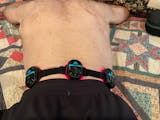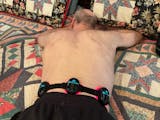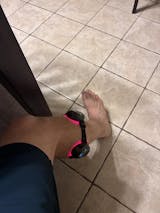Knee pain is a problem that affects many people, whether due to injury, age, or other underlying conditions. The discomfort can make even simple tasks like walking or climbing stairs difficult. If you’re looking for a fast and effective way to
relieve knee pain, you’ve come to the right place. This article will explore several methods that can help you find relief quickly, including the benefits of
medical-grade red light therapy devices.
Understanding the Causes of Knee Pain
Before we dive into how to relieve knee pain, it’s important to understand its causes. Different conditions can lead to knee pain, and knowing what’s at the root of your discomfort can help guide the best treatment options.
Osteoarthritis and Its Impact
Osteoarthritis is one of the most common causes of
chronic knee pain, particularly in older adults. This condition occurs when the cartilage in your knee joint breaks down, causing friction between bones and leading to pain and stiffness. If you suffer from osteoarthritis, treatments like
red light therapy module - PRUNGO FluxGo can help reduce inflammation and improve mobility.
Injuries and Trauma to the Knee
Knee injuries, such as sprains, strains, or ligament tears, are common causes of sudden knee pain. Whether caused by sports, a fall, or overexertion, injuries can lead to sharp pain and swelling. Quick treatments like ice and compression can help, but advanced solutions like FDA approved red light therapy can speed up recovery and promote healing in the damaged tissues.
Patellar Tendonitis
This condition affects the tendon connecting your kneecap to the shinbone. It’s common in athletes and those who perform repetitive movements like running or jumping. The result is pain and inflammation just below the knee cap. Red light therapy at home can assist in reducing inflammation, helping you recover faster and get back to activity sooner.
Rheumatoid Arthritis
Unlike osteoarthritis, rheumatoid arthritis is an autoimmune condition where the body's immune system attacks the joints. This results in swelling, pain, and stiffness in the knees. FDA approved red light therapy can support the body's natural healing processes, reduce inflammation, and ease pain associated with rheumatoid arthritis.
Bursitis
Bursitis is the inflammation of the bursae, the small fluid-filled sacs around the knee. It can cause pain, swelling, and tenderness. While rest and ice are helpful,
Red light therapy machines can speed up recovery by stimulating blood flow and reducing swelling.
Fast Ways to Relieve Knee Pain
When knee pain strikes, finding quick relief is essential. Here are some effective ways to manage the pain and reduce discomfort, starting right at home.
Rest and Elevation
Taking a break from physical activity is one of the first steps in alleviating knee pain. Resting your knee and elevating it can help reduce swelling and give your body time to heal. This simple step can often provide immediate comfort, especially after an injury.
Ice Therapy for Swelling
Applying an ice pack to the knee for about 15–20 minutes every hour can help reduce swelling and numb the pain. This is especially useful within the first 48 hours after an injury. Be sure to wrap the ice in a cloth to prevent direct contact with the skin, which could cause ice burns.
Compression to Reduce Swelling
Compression wraps or knee braces can provide additional support and help reduce swelling. The gentle pressure from compression can also help keep the knee stable while promoting better circulation.
Over-the-Counter Pain Medications
For more intense pain, over-the-counter pain relievers such as ibuprofen can provide temporary relief. These medications work by reducing inflammation and alleviating pain. However, they should be used sparingly and according to the directions on the label.
Heat Therapy for Stiffness
After the initial swelling has gone down, using heat can help relax the muscles around the knee and reduce stiffness. A warm towel or heating pad can be applied to the knee for 15–20 minutes, which will help promote flexibility and ease discomfort.
The Role of Physical Therapy in Knee Pain Relief
While quick solutions are useful, physical therapy plays a significant role in the long-term relief of knee pain. By targeting the muscles around your knee, physical therapy helps strengthen the area, improve mobility, and prevent future injuries.
Targeted Exercises for Knee Strength
Strengthening the muscles that surround the knee joint can help improve its function and stability. Physical therapists often recommend specific exercises that target the quadriceps, hamstrings, and calves, which can support the knee and reduce pain.
Stretching for Flexibility
Stretching is another key aspect of physical therapy. It helps to improve the flexibility of the muscles and ligaments around the knee, which can reduce tension and stiffness. Regular stretching can make it easier to move the knee and prevent future injuries.
Manual Therapy and Massage
Physical therapists can also use manual therapy techniques, such as massage, to relieve tightness in the muscles and soft tissues around the knee. This can increase blood flow, reduce pain, and improve overall mobility.
Hydrotherapy
Water-based exercises are excellent for individuals with knee pain, as the buoyancy of the water reduces pressure on the joint. Hydrotherapy can help strengthen the knee while minimizing the risk of further injury, making it a great option for long-term recovery.
How Medical-Grade Red Light Therapy Devices Help
For fast and effective knee pain relief, medical-grade red light therapy devices are an innovative treatment that has shown great promise. Here's how they can help:
How Red Light Therapy Works
Red light therapy uses low-level wavelengths of light to penetrate deep into tissues, stimulating cellular repair and promoting healing. This process helps reduce inflammation, which is a common cause of knee pain, and accelerates recovery.
Benefits for Arthritis and Joint Pain
Fda approved red light therapy devices for pain is particularly effective for individuals suffering from osteoarthritis and other forms of joint pain. By reducing inflammation and promoting circulation, it can ease pain and improve mobility, allowing for quicker relief compared to traditional methods.
Non-Invasive and Safe Treatment
One of the biggest advantages of red light therapy is that it is a non-invasive, drug-free treatment option. Unlike injections or surgeries, it doesn’t carry any major risks, making it a safe and effective solution for knee pain.
How to Use Medical-Grade Red Light Therapy Devices
Using red light therapy devices is easy. Most devices come with clear instructions, and treatment sessions typically last between 10 to 20 minutes. Regular use can lead to noticeable improvements in pain relief and overall knee function.
When to See a Doctor for Knee Pain
Although self-care treatments can help, there are times when professional medical help is necessary. Here’s when you should consult a doctor for knee pain:
Severe Pain and Swelling
If your knee pain is severe or you notice significant swelling, it could indicate a serious injury or condition, such as a ligament tear or a fracture. Seek medical attention if the pain doesn’t improve after a few days of rest and self-care.
Inability to Bear Weight
If you can’t put weight on your knee or if it becomes unstable, this is a sign that you need to consult a healthcare provider. An inability to bear weight could indicate significant damage to the knee joint.
Persistent or Chronic Pain
Knee pain that lasts for weeks or doesn’t improve with at-home treatments should be evaluated by a doctor. Chronic pain may be a sign of a condition like arthritis or a repetitive stress injury that requires specialized treatment.
Sudden Changes in Appearance or Movement
If you notice deformities in your knee or have difficulty moving it, you may have a serious injury or underlying condition. A healthcare professional can perform diagnostic tests and recommend the appropriate treatment.
Conclusion
Knee pain can be excruciating, but fortunately, there are many effective ways to relieve it. Whether it's basic home remedies like rest and ice packs, or advanced technologies like
red light therapy, the key is to find a treatment that suits your individual situation. If the pain persists or worsens, it's essential to seek evaluation from a medical professional promptly. For treatments requiring extensive irradiation,
red light therapy panels are a good option; if you're focused on facial care,
red light therapy masks can cover multiple facial areas, making them particularly suitable for anti-aging, soothing and repairing, improving skin health, reducing fine lines, and effectively alleviating acne.





















Share:
How to Sleep with Neck Pain
How Long to Recover from Knee Replacement